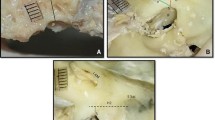Abstract
Purpose
To describe an anatomical variant that should be consider in patients with hearing loss.
Methods
An 8-year-old girl underwent to temporal bone computed tomography for the evaluation of bilateral conductive hearing loss and further assessment of possible enlarged vestibular aqueduct or high jugular bulb on brain magnetic resonance imaging (MRI).
Results
CT of temporal bone showed a cystic cavity with bony sclerotic margins extending from the right jugular foramen to the vestibular aqueduct. Bony dehiscence of the jugular foramen with the right carotid canal was also noted. On brain MRI, there was no evidence of enlargement of the endolymphatic duct and sac on T2 thin-section gradient echo sequence. Time of flight MR angiography did not show arterial flow in the cavity. Contrast enhanced MR venography confirmed the presence of a high right jugular bulb with a diverticulum extending into the vestibular aqueduct due to jugular bulb-vestibular aqueduct dehiscence.
Conclusion
Knowledge of high jugular bulb-vestibular aqueduct dehiscence is important in the assessment of patients with otologic symptoms such as vertigo, tinnitus and hearing loss.


Similar content being viewed by others
Availability of data and materials
Not applicable.
Code availability
Not applicable.
References
Friedmann DR, Eubig J, Winata LS, Pramanik BK, Merchant SN, Lalwani AK (2012) A clinical and histopathologic study of jugular bulb abnormalities. Arch Otolaryngol Head Neck Surg 138(1):66–71. https://doi.org/10.1001/archoto.2011.231
Okudera T, Huang YP, Ohta T, Yokota A, Nakamura Y, Maehara F, Utsunomiya H, Uemura K, Fukasawa H (1994) Development of posterior fossa dural sinuses, emissary veins, and jugular bulb: morphological and radiologic study. AJNR Am J Neuroradiol 15(10):1871–1883
van Rompaey V, Offeciers E, de Foer B, Somers T (2012) Jugular bulb diverticulum dehiscence towards the vestibular aqueduct in a patient with otosclerosis. J Laryngol Otol 126(3):313–315. https://doi.org/10.1017/S0022215111003100
Sayit AT, Gunbey HP, Fethallah B, Gunbey E, Karabulut E (2016) Radiological and audiometric evaluation of high jugular bulb and dehiscent high jugular bulb. J Laryngol Otol 130(11):1059–1063. https://doi.org/10.1017/S0022215116009166
Singla A, Gupta T, Sahni D, Aggarwal A, Gupta A (2016) High jugular bulb: different osseous landmarks and their clinical implications. Surg Radiol Anat 38(8):903–909. https://doi.org/10.1007/s00276-016-1649-2
Hourani R, Carey J, Yousem DM (2005) Dehiscence of the jugular bulb and vestibular aqueduct: findings on 200 consecutive temporal bone computed tomography scans. J Comput Assist Tomogr 29(5):657–662. https://doi.org/10.1097/01.rct.0000175499.34213.5d
Li S, Shen N, Cheng Y, Sha Y, Wang Z (2015) The effect of jugular bulb-vestibular aqueduct dehiscence on hearing and balance. Acta Otolaryngol 135(11):1103–1107. https://doi.org/10.3109/00016489.2015.1062141
Friedmann DR, Le BT, Pramanik BK, Lalwani AK (2010) Clinical spectrum of patients with erosion of the inner ear by jugular bulb abnormalities. Laryngoscope 120(2):365–372. https://doi.org/10.1002/lary.20699
Madden C, Halsted M, Meinzen-Derr J, Bardo D, Boston M, Arjmand E, Nishimura C, Yang T, Benton C, Das V, Smith R, Choo D, Greinwald J (2007) The influence of mutations in the SLC26A4 gene on the temporal bone in a population with enlarged vestibular aqueduct. Arch Otolaryngol Head Neck Surg 133(2):162–168. https://doi.org/10.1001/archotol.133.2.162
Acknowledgements
Department of radiology – Hospital Universitario Fundación Santa Fe de Bogotá.
Funding
Not applicable.
Author information
Authors and Affiliations
Contributions
AG: project development, data collection, manuscript writing and final approval. JAM: manuscript writing–editing. OT: manuscript writing–editing.
Corresponding author
Ethics declarations
Conflict of interest
The authors have no conflicts of interest to disclose.
Ethical approval
Ethical approval from the institutional review board was not required for this study. The article does not contain photographs or indication that could be traced back to a human participant. The patient gave a written informed consent for all testing during the clinical process, namely, for temporal bone computed tomography and magnetic resonance imaging.
Additional information
Publisher's Note
Springer Nature remains neutral with regard to jurisdictional claims in published maps and institutional affiliations.
Rights and permissions
About this article
Cite this article
Guarnizo, A., Mejía, J.A. & Torres, O. High jugular bulb with a diverticulum and vestibular aqueduct dehiscence: an anatomical variant to be aware in patients with hearing loss. Surg Radiol Anat 44, 1041–1044 (2022). https://doi.org/10.1007/s00276-022-02983-y
Received:
Accepted:
Published:
Issue Date:
DOI: https://doi.org/10.1007/s00276-022-02983-y




